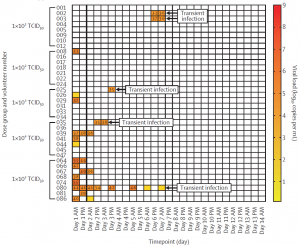In a new study, researchers sought to identify an effective dose of pre-alpha SARS-CoV-2 virus that induced infection in previously infected individuals (Figure 1). Pre-alpha SARS-CoV-2 virus refers to the initial strains of the SARS-CoV-2 virus that were circulating before the emergence of the Alpha variant.

Figure 1: “Positive PCRs during quarantine: All swabs taken during the quarantine period. Coloured squares denote detection of SARS-CoV-2 by qRT-PCR with viral load values presented; positive detections below the LLOQ are highlighted in yellow with no associated value for viral load. The five volunteers considered to demonstrate transient infection are labelled. All other SARS CoV-2- positive swabs were considered to represent residual inoculum, with initial viral detection occurring on day 1 (denoted by thick black line). The LLOQ for quantitative RT-PCR (qRT-PCR) was 3 log10 copies per mL, with positive detections less than the LLOQ assigned a value of 1⋅5 log10 copies per mL and undetectable samples assigned a value of 0 log10 copies per mL” .
The authors believe that a controlled human infection model (CHIM) can aid vaccine development efforts, however, to get there researchers still need to unpack the host immune responses responsible for driving long-lasting immunity and providing protection.
This study would be the first to SARS-CoV-2 CHIM conducted in seropositive individuals. Study participants in this phase 1 open-label study were between the ages of 18 and 30, living in the UK and had evidence of prior SARS-CoV-2 infection as seen from a positive PCR or lateral flow antigen test. The dosing groups and study design were set up to mirror that of a seronegative CHIM study conducted by Killingley and colleagues.
The primary outcome of the study was to identify a dose of pre-alpha SARS-CoV-2 that was safe enough to induce infection in up to 50% of the individuals enrolled in the study. 14% (5 out of 36) of the people enrolled and eligible to participate in the study showed signs of transient infection however, 2 people did not meet the primary endpoint pre-specified definition of infection. All five individuals with signs of transient infection span across different dosing groups (Figure 1). Most adverse events were categorized as mild and by day 18 all adverse events had resolved.
Individuals who developed transient infection had lower IFNγ– ELISpot responses to CD8+ T-cell epitope peptides in comparison to those who remained uninfected. Furthermore, no increase in IFNγ– ELISpot responses were identified post-exposure.
The authors conclude that despite an increase in the dose given, they were not able to establish sustained SARS-CoV-2 infection. This was one of the points highlighted by the authors in the discussion section of the paper: “Although this current study was not designed to assess vaccine efficacy, this finding suggests that previous infection, together with vaccination with pre-alpha spike vaccines, offers strong homologous protection against a pre-alpha challenge strain up to a dose of 1×105 TCID50”.
The results from the paper alongside field epidemiological data led the authors to suggest that the study provides proof of hybrid immunity being able to offer resistance against re-infection.
Journal article: Jackson, S. et al., 2024. Safety, tolerability, viral kinetics, and immune correlates of protection in healthy, seropositive UK adults inoculated with SARS-COV-2: A single-centre, open-label, phase 1 controlled Human infection study. The Lancet Microbe [Preprint].
Summary by Vanessa Mwebaza Muwanga










